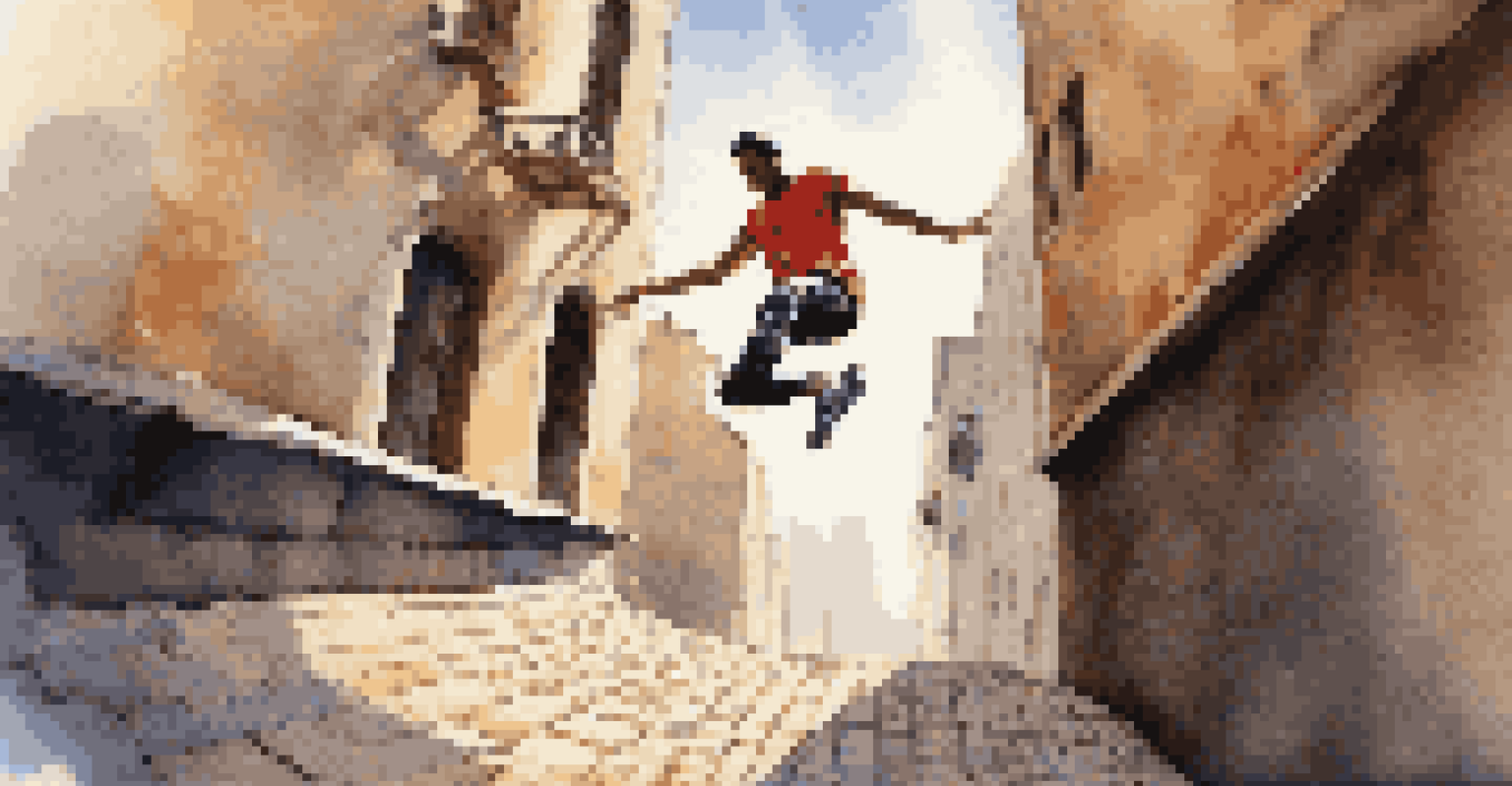Parkour and Self-Defense: Practical Applications Explained

Understanding Parkour: More Than Just a Sport
Parkour is often viewed as an extreme sport focused on moving fluidly through an environment, typically urban landscapes. However, it's much more than just flashy moves; it's about overcoming obstacles both physically and mentally. This mindset of adaptability and agility is what makes parkour relevant in self-defense scenarios.
The obstacle is the path.
Imagine you're in a tight situation where you need to escape quickly. The ability to vault over a railing or scale a wall can be a game-changer. Parkour trains your body to find the most efficient routes through obstacles, which can help you evade potential threats or dangerous situations.
Moreover, parkour encourages awareness of your surroundings. Practitioners learn to assess environments quickly, which is a crucial skill in self-defense. By understanding how to navigate spaces effectively, you become more prepared to react in high-pressure situations.
The Connection Between Agility and Self-Defense
Agility is a key component of both parkour and self-defense. In parkour, agility allows you to move swiftly and change directions effortlessly, which can be incredibly valuable when trying to escape or evade an attacker. This physical training enhances your reflexes, making it easier to react in real-time situations.

For example, if someone tries to grab you, your parkour training could help you slip away by quickly maneuvering around them. The more agile you are, the more options you have when faced with a threat. This flexibility in movement can often mean the difference between safety and danger.
Parkour Enhances Self-Defense Skills
Practicing parkour builds agility and awareness, crucial for effective self-defense in high-pressure situations.
Additionally, parkour helps build core strength and balance, which are essential in self-defense techniques. A strong core allows you to stay grounded while executing evasive maneuvers, ensuring that you remain in control, even in chaotic situations.
Mindset: How Parkour Prepares You for Conflict
One of the most significant benefits of parkour is the mental resilience it instills. Practitioners learn to confront their fears, push their limits, and develop a 'can-do' attitude. This mindset can be incredibly beneficial in self-defense situations, where staying calm under pressure is paramount.
In the midst of chaos, there is also opportunity.
Picture a scenario where you're confronted by an aggressor. The ability to maintain composure, think clearly, and plan your next move is vital. Parkour teaches you to face challenges head-on, which translates well into the mental approach needed for self-defense.
Moreover, the practice of parkour fosters a sense of confidence. As you master challenging moves, your self-assurance grows, equipping you with the belief that you can handle difficult situations, both physically and mentally.
Practical Techniques: Parkour Moves for Self-Defense
Certain parkour techniques can be directly applied in self-defense scenarios. For instance, the roll, which is a fundamental parkour skill, can help you safely absorb the impact of a fall or a push. Knowing how to roll effectively can prevent injury while allowing you to escape quickly.
Another useful technique is the precision jump, which helps you navigate through tight spaces. If you find yourself needing to escape through a narrow alley or over a low fence, this skill can come in handy. It's about using your environment to your advantage, a principle that both parkour and self-defense emphasize.
Mental Resilience from Parkour
The mindset developed through parkour fosters confidence and calmness, essential for confronting potential threats.
Lastly, parkour's vaulting techniques allow you to navigate obstacles like tables or benches quickly. In a self-defense context, being able to clear obstacles can help you evade an attacker or create distance, increasing your chances of escape.
Situational Awareness: A Parkour Principle in Action
Situational awareness is a critical element in both parkour and self-defense. In parkour, you learn to constantly evaluate your environment, looking for potential obstacles and escape routes. This skill directly translates to being aware of your surroundings in everyday life, especially in potentially risky situations.
For instance, when walking down a street, a parkour practitioner would instinctively note exits and obstacles. This heightened awareness can alert you to potential threats or even help you avoid dangerous areas altogether. It's about being proactive rather than reactive.
Furthermore, this awareness allows you to assess the behavior of those around you. By recognizing unusual patterns or signs of aggression early, you can take steps to protect yourself before a situation escalates.
Building Physical Fitness Through Parkour
Engaging in parkour not only equips you with practical skills but also significantly boosts your physical fitness. The combination of strength, flexibility, and endurance training involved in parkour prepares your body for the demands of self-defense. Strong muscles and a flexible body can help you react faster and more effectively.
For example, the explosive power needed for a jump is similar to the strength required for defensive maneuvers. As you practice parkour, you develop a fitness level that enhances your ability to defend yourself, ensuring that you have the stamina to escape or confront an attacker.
Physical Fitness Boost from Parkour
Engaging in parkour improves overall fitness, providing strength and endurance vital for self-defense scenarios.
Additionally, parkour workouts often include dynamic movements that improve cardiovascular health, further contributing to your overall fitness. This physical preparation not only benefits your self-defense skills but also enhances your confidence and resilience in everyday life.
Combining Parkour and Self-Defense: A Holistic Approach
Integrating parkour techniques into self-defense training creates a holistic approach to personal safety. By combining the agility and awareness gained from parkour with self-defense techniques, you equip yourself with a versatile skill set. This synergy allows you to navigate various situations more effectively.
Moreover, training in both disciplines can be incredibly empowering. The confidence gained from mastering parkour skills can enhance your self-defense capabilities, providing you with the tools to handle a range of scenarios. This empowerment fosters a proactive mindset, enabling you to take control of your personal safety.

Ultimately, the blend of parkour and self-defense not only prepares you physically but also mentally for unexpected challenges. It’s about building resilience, awareness, and the ability to adapt—qualities that are essential in safeguarding yourself in an unpredictable world.